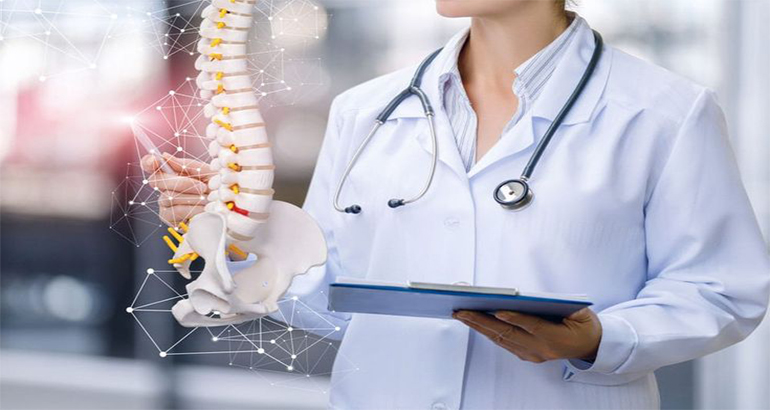
Osteoporosis is a condition characterised by a decrease in the density of bone, decreasing its strength and resulting in fragile bones. Osteoporosis literally leads to abnormally porous bone that is compressible, like a sponge. This disorder of the skeleton weakens the bone and results in frequent fractures (breaks) in the bones. Osteopenia is a condition of bone that is slightly less dense than normal bone but not to the degree of bone in osteoporosis. Normal bone is composed of protein, collagen, and calcium, all of which give bone its strength. Bones that are affected by osteoporosis can break (fracture) with relatively minor injury that normally would not cause a bone to fracture. The fracture can be either in the form of cracking (as in a hip fracture) or collapsing (as in a compression fracture of the vertebrae of the spine). The spine, hips, ribs, and wrists are common areas of bone fractures from osteoporosis although osteoporosis-related fractures can occur in almost any skeletal bone.
Causes and Symptoms
Worldwide, osteoporosis causes more than 8.9 million fractures annually, resulting in an osteoporotic fracture every 3 seconds. Osteoporosis is estimated to affect 200 million women worldwide – approximately one-tenth of women aged 60, one-fifth of women aged 70, two-fifths of women aged 80 and two-thirds of women aged 90
Osteoporosis can be influenced by the following risk factors:
- Genetics – Studies of mothers and daughters have shown that heredity plays a role in bone density.
- Menopause – Particularly in those not taking hormone replacement therapy.
- Poor intake of calcium – Calcium intake in the diet plays a vital role in bone mineralization during the growth years and is essential to depositing an abundant supply of calcium into the bones. Even after maximum bone mass has been achieved, calcium intake continues to be important to help slow down bone loss later in life. Dairy products are one of the best sources of calcium, but many people choose not to eat them or can’t tolerate them because of lactose intolerance or allergy. Other food sources of calcium are canned sardines, dark green vegetables like broccoli, collard greens and bok choy, as well as tofu and calcium-fortified juices and soy milk. However, a supplement is recommended to ensure you are getting enough.
- Lack of Vitamin D – Vitamin D plays a pivotal role in allowing the body to absorb calcium. Vitamin D is synthesized naturally in the skin when it is exposed to sunlight. It is also available in fortified milk and cereals. However, many people do not produce enough vitamin D or get enough from food. Vitamin D deficiency can be a problem for older people and those who are homebound or bed-ridden.
- Inactivity – Weight-bearing activities such as walking, jogging and weight training help to maintain bone density. A sedentary lifestyle promotes bone loss as well as muscle loss. Conversely, muscle use promotes the building of bone. Regular physical activity strengthens both muscles and bones, slows down bone loss and decreases the risk of injury from falls.
- Smoking – The relationship between bone loss and smoking has been confirmed by numerous studies. However, once you quit smoking, even later in life, the bone loss influenced by this habit can be minimized.
- Excessive alcohol intake – People who drink alcohol to excess are more prone to fractures. This may be partially due to the diuretic effect of alcohol, which induces calcium losses through the urine. Alcohol can also decrease the absorption of calcium from the intestines and cause deficiencies in vitamin D and magnesium – both of which are important to bone health.
- High sodium intake – Several studies have demonstrated the harmful effects of high dietary sodium on bone integrity. Reducing sodium intake can reduce bone loss considerably.
- Coffee – Coffee consumption of more than two cups a day may contribute to accelerated bone loss.
- High consumption of animal protein – Some studies have shown that a diet high in animal protein actually promotes bone loss by leaching calcium from the bones, although the verdict is still out on this issue.
- Medications – Certain medications, such as steroids and anticonvulsants, may contribute to bone demineralization.
Treatment
Sannidhya Multispeciality Hospital strives to provide quality care for patients seeking osteoporosis treatment. The Osteoporosis Center combines clinical care, research and education to provide early detection of the disease and reduce its spread.
With state-of-the-art technology and the latest techniques for measuring bone density, the Center specialises in treatment of osteoporosis, metabolic bone disease, and disorders in skeletal and calcium homeostasis. The Center’s bone density unit features bone density machines, a bone ultrasound machine and imaging procedures to evaluate three-dimensional constructs of bone and muscle.

